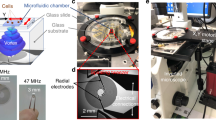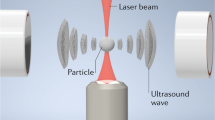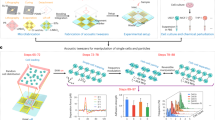Abstract
Precise and selective manipulation of colloids and biological cells has long been motivated by applications in materials science, physics and the life sciences. Here we introduce our harmonic acoustics for a non-contact, dynamic, selective (HANDS) particle manipulation platform, which enables the reversible assembly of colloidal crystals or cells via the modulation of acoustic trapping positions with subwavelength resolution. We compose Fourier-synthesized harmonic waves to create soft acoustic lattices and colloidal crystals without using surface treatment or modifying their material properties. We have achieved active control of the lattice constant to dynamically modulate the interparticle distance in a high-throughput (>100 pairs), precise, selective and reversible manner. Furthermore, we apply this HANDS platform to quantify the intercellular adhesion forces among various cancer cell lines. Our biocompatible HANDS platform provides a highly versatile particle manipulation method that can handle soft matter and measure the interaction forces between living cells with high sensitivity.
This is a preview of subscription content, access via your institution
Access options
Access Nature and 54 other Nature Portfolio journals
Get Nature+, our best-value online-access subscription
$29.99 / 30 days
cancel any time
Subscribe to this journal
Receive 12 print issues and online access
$259.00 per year
only $21.58 per issue
Buy this article
- Purchase on Springer Link
- Instant access to full article PDF
Prices may be subject to local taxes which are calculated during checkout




Similar content being viewed by others
Data availability
All the data supporting the findings of this study are available in the article and its Supplementary Information. Further information is available from the corresponding author on reasonable request.
Code availability
The acoustic wave simulations were performed with commercial software MATLAB. Computation details can be made available from the corresponding authors on request.
References
Li, B., Zhou, D. & Han, Y. Assembly and phase transitions of colloidal crystals. Nat. Rev. Mater. 1, 15011 (2016).
Hou, J., Li, M. & Song, Y. Recent advances in colloidal photonic crystal sensors: materials, structures and analysis methods. Nano Today 22, 132–144 (2018).
Lim, M. X., Souslov, A., Vitelli, V. & Jaeger, H. M. Cluster formation by acoustic forces and active fluctuations in levitated granular matter. Nat. Phys. 15, 460–464 (2019).
Ozcelik, A. et al. Acoustic tweezers for the life sciences. Nat. Methods 15, 1021–1028 (2018).
Guo, J. et al. Modular assembly of superstructures from polyphenol-functionalized building blocks. Nat. Nanotechnol. 11, 1105–1111 (2016).
Manoharan, V. N. Colloidal matter: packing, geometry, and entropy. Science 349, 1253751 (2015).
Aubret, A., Youssef, M., Sacanna, S. & Palacci, J. Targeted assembly and synchronization of self-spinning microgears. Nat. Phys. 14, 1114–1118 (2018).
Liu, B. et al. Switching plastic crystals of colloidal rods with electric fields. Nat. Commun. 5, 3092 (2014).
Demirors, A. F., Pillai, P. P., Kowalczyk, B. & Grzybowski, B. A. Colloidal assembly directed by virtual magnetic moulds. Nature 503, 99–103 (2013).
Yang, D., Ye, S. & Ge, J. Solvent wrapped metastable colloidal crystals: highly mutable colloidal assemblies sensitive to weak external disturbance. J. Am. Chem. Soc. 135, 18370–18376 (2013).
Ashkin, A., Dziedzic, J. M. & Yamane, T. Optical trapping and manipulation of single cells using infrared laser beams. Nature 330, 769–771 (1987).
Guo, F. et al. Controlling cell-cell interactions using surface acoustic waves. Proc. Natl Acad. Sci. USA 112, 43–48 (2015).
Collins, D. J. et al. Two-dimensional single-cell patterning with one cell per well driven by surface acoustic waves. Nat. Commun. 6, 8686 (2015).
Sitters, G. et al. Acoustic force spectroscopy. Nat. Methods 12, 47–50 (2015).
Kamsma, D. et al. Single-cell acoustic force spectroscopy: resolving kinetics and strength of T cell adhesion to fibronectin. Cell Rep. 24, 3008–3016 (2018).
Marzo, A. & Drinkwater, B. W. Holographic acoustic tweezers. Proc. Natl Acad. Sci. USA 116, 84–89 (2019).
Melde, K., Mark, A. G., Qiu, T. & Fischer, P. Holograms for acoustics. Nature 537, 518–522 (2016).
Hirayama, R., Plasencia, D. M., Masuda, N. & Subramanian, S. A volumetric display for visual, tactile and audio presentation using acoustic trapping. Nature 575, 320–323 (2019).
Tian, Z. et al. Wave number–spiral acoustic tweezers for dynamic and reconfigurable manipulation of particles and cells. Sci. Adv. 5, eaau6062 (2019).
Baudoin, M. et al. Folding a focalized acoustical vortex on a flat holographic transducer: miniaturized selective acoustical tweezers. Sci. Adv. 5, eaav1967 (2019).
Friend, J. R. & Yeo, L. Y. Microscale acoustofluidics: Microfluidics driven via acoustics and ultrasonics. Rev. Mod. Phys. 83, 647–704 (2011).
Huang, P. H. et al. Acoustofluidic synthesis of particulate nanomaterials. Adv. Sci. 6, 1900913 (2019).
Gu, Y. et al. Acoustofluidic centrifuge for nanoparticle enrichment and separation. Sci. Adv. 7, eabc0467 (2021).
Fan, X.-D., Zou, Z. & Zhang, L. Acoustic vortices in inhomogeneous media. Phys. Rev. Res. 1, 032014 (2019).
Delsing, P. et al. The 2019 surface acoustic waves roadmap. J. Phys. D 52, 353001 (2019).
Schuetz, M. J. et al. Acoustic traps and lattices for electrons in semiconductors. Phys. Rev. X 7, 041019 (2017).
Schülein, F. J. et al. Fourier synthesis of radiofrequency nanomechanical pulses with different shapes. Nat. Nanotechnol. 10, 512–516 (2015).
Weiß, M. et al. Optomechanical wave mixing by a single quantum dot. Optica 8, 291–300 (2021).
Hosseini, B. H. et al. Immune synapse formation determines interaction forces between T cells and antigen-presenting cells measured by atomic force microscopy. Proc. Natl Acad. Sci. USA 106, 17852–17857 (2009).
Liu, B., Chen, W., Evavold, B. D. & Zhu, C. Accumulation of dynamic catch bonds between TCR and agonist peptide-MHC triggers T cell signaling. Cell 157, 357–368 (2014).
Dholakia, K. & Reece, P. Optical micromanipulation takes hold. Nano Today 1, 18–27 (2006).
Feng, Y. et al. Mechanosensing drives acuity of αβ T-cell recognition. Proc. Natl Acad. Sci. USA 114, E8204–E8213 (2017).
Chen, S. & Lee, L. P. Non-invasive microfluidic gap junction assay. Integr. Biol. 2, 130–138 (2010).
Glynne-Jones, P., Boltryk, R. J., Harris, N. R., Cranny, A. W. & Hill, M. Mode-switching: a new technique for electronically varying the agglomeration position in an acoustic particle manipulator. Ultrasonics 50, 68–75 (2010).
Marzo, A., Caleap, M. & Drinkwater, B. W. Acoustic virtual vortices with tunable orbital angular momentum for trapping of mie particles. Phys. Rev. Lett. 120, 044301 (2018).
Auwerx, J. The human leukemia cell line, THP-1: a multifacetted model for the study of monocyte-macrophage differentiation. Experientia 47, 22–31 (1991).
Chu, Y. S. et al. Force measurements in E-cadherin-mediated cell doublets reveal rapid adhesion strengthened by actin cytoskeleton remodeling through Rac and Cdc42. J. Cell Biol. 167, 1183–1194 (2004).
Casella, J. F., Flanagan, M. D. & Lin, S. Cytochalasin D inhibits actin polymerization and induces depolymerization of actin filaments formed during platelet shape change. Nature 293, 302–305 (1981).
Kang, J. H. et al. Noninvasive monitoring of single-cell mechanics by acoustic scattering. Nat. Methods 16, 263–269 (2019).
Palmer, C. P. et al. Single cell adhesion measuring apparatus (SCAMA): application to cancer cell lines of different metastatic potential and voltage-gated Na+ channel expression. Eur. Biophys. J. 37, 359–368 (2008).
Acknowledgements
We acknowledge support from the Shared Materials Instrumentation Facility at Duke University. We thank S. Suresh, M. Dao, Z. Mao and J. Rich for their critical feedback and helpful discussions. We acknowledge support from the National Institutes of Health (grant numbers R01GM141055 (T.J.H.), R01GM132603 (T.J.H.), U18TR003778 (T.J.H.) and UH3TR002978 (T.J.H.)) and the National Science Foundation (grant numbers ECCS-1807601 (T.J.H.) and CMMI-2104295 (T.J.H.)).
Author information
Authors and Affiliations
Contributions
S.Y. conceived the idea. S.Y., Z.T., P.L., L.P.L. and T.J.H. designed the research. S.Y. performed the research. Z.W. performed the western blot analysis. S.Y., J.X. and C.C. did the simulation. S.Y., Z.W., Z.T., H.B., C.C., P.L., P.-H.H., M.W., L.P.L. and T.J.H. analysed data. S.Y., P.-H.H., H.B., Z.T. and L.P.L. drew the figures. S.Y., Z.T., Z.W., H.B., P.L., P.-H.H., J.R., J.M., L.P.L. and T.J.H. wrote the paper. S.Y., Z.T., J.R., H.B., P.L., J.M., L.P.L. and T.J.H. revised the paper.
Corresponding authors
Ethics declarations
Competing interests
T.J.H. has cofounded a start-up company, Ascent Bio-Nano Technologies Inc., to commercialize technologies involving acoustofluidics and acoustic tweezers. The remaining authors declare no competing interests.
Peer review
Peer review information
Nature Materials thanks Hubert Krenner, Adrian Neild and the other, anonymous, reviewer(s) for their contribution to the peer review of this work.
Additional information
Publisher’s note Springer Nature remains neutral with regard to jurisdictional claims in published maps and institutional affiliations.
Supplementary information
Supplementary Information
Supplementary Notes 1–8, Figs. 1–6 and Table 1.
Supplementary Video 1
Selective and reversible pairing of two cells (U937) by the HANDS platform while keeping neighbouring cells intact.
Supplementary Video 2
Creation of colloidal crystal from a cluster by the HANDS platform.
Supplementary Video 3
Controls of rotational direction and spinning of a colloidal crystal monolayer by the HANDS platform.
Supplementary Video 4
Different crystal configurations of colloidal monolayers with varied spin speeds (with particle number n = 6) by the HANDS platform.
Supplementary Video 5
Reconfiguration of acoustic wells for single-colloid trapping and pairing by the HANDS platform: connected acoustic wells and isolated acoustic wells.
Supplementary Video 6
Demonstration of the repeatable and reversible pairing of single particles by the HANDS platform.
Supplementary Video 7
High-throughput pairing for colloidal particles and cells by the HANDS platform.
Supplementary Video 8
Reversible pairing of living cells (U937) in the x and y directions by the HANDS platform.
Rights and permissions
Springer Nature or its licensor (e.g. a society or other partner) holds exclusive rights to this article under a publishing agreement with the author(s) or other rightsholder(s); author self-archiving of the accepted manuscript version of this article is solely governed by the terms of such publishing agreement and applicable law.
About this article
Cite this article
Yang, S., Tian, Z., Wang, Z. et al. Harmonic acoustics for dynamic and selective particle manipulation. Nat. Mater. 21, 540–546 (2022). https://doi.org/10.1038/s41563-022-01210-8
Received:
Accepted:
Published:
Issue Date:
DOI: https://doi.org/10.1038/s41563-022-01210-8
This article is cited by
-
Aerosol jet printing of surface acoustic wave microfluidic devices
Microsystems & Nanoengineering (2024)
-
Acoustic-driven magnetic skyrmion motion
Nature Communications (2024)
-
High-yield and rapid isolation of extracellular vesicles by flocculation via orbital acoustic trapping: FLOAT
Microsystems & Nanoengineering (2024)
-
Cavity-agnostic acoustofluidic manipulations enabled by guided flexural waves on a membrane acoustic waveguide actuator
Microsystems & Nanoengineering (2024)
-
Acoustofluidic Interfaces for the Mechanobiological Secretome of MSCs
Nature Communications (2023)



